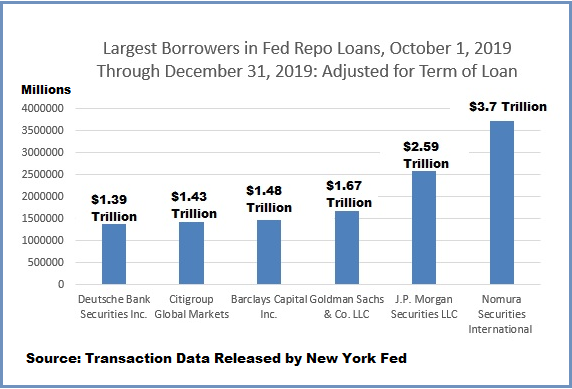SUBSCRIBE TO THIS NEWSLETTER TO RECEIVE TIMELY REPORTS!
Wall Street Mega Banks Have Drawn a Law-Free Zone Around Themselves – The Media Is Complicit
By Pam Martens: March 13, 2024 ~
 From revoking the American people’s right to a jury trial in matters involving Wall Street; to brazenly thumbing their nose at anti-trust law; to trading the stock of their own bank in the darkness of their own dark pools; to forming their own stock exchange; to committing serial felonies without being criminally prosecuted or having their bank charters revoked – Wall Street mega banks have drawn a law-free zone around themselves and are more dangerous today than they have ever been in U.S. history.
From revoking the American people’s right to a jury trial in matters involving Wall Street; to brazenly thumbing their nose at anti-trust law; to trading the stock of their own bank in the darkness of their own dark pools; to forming their own stock exchange; to committing serial felonies without being criminally prosecuted or having their bank charters revoked – Wall Street mega banks have drawn a law-free zone around themselves and are more dangerous today than they have ever been in U.S. history.
The most dangerous eras for the American people versus Wall Street mega banks have been the late 1920s and 1930s; 2007 to 2010; and today. We know that today is the most dangerous era because we read 12,000 pages produced by the Senate Banking Committee of the early 1930s on the Wall Street corruption in the late 20s and 30s; we read every government report produced on the causes of the crash of 2008 and its aftermath, as well as every important book on the subject; and we have personally chronicled at Wall Street On Parade the unprecedented corruption of the Wall Street mega banks since 2008.
One key factor stands out in our mind as to why today’s Wall Street mega bank era is so much more corrupt and dangerous than earlier times: the failure of mainstream media to do its job.
For the past decade, mainstream media has failed to adequately report to the American people the activities of the Wall Street mega banks and the insidious role of the Federal Reserve in being their secret bailout kingpin. Consider what happened with the Fed’s so-called repo loan bailouts in the last quarter of 2019.
On September 17, 2019 the overnight repo loan rate spiked from an average of about 2 percent to 10 percent – signaling that one or more important Wall Street firms were in trouble. The repo loan market is an overnight loan market where banks, brokerage firms, mutual funds and others make predominantly one-day loans to each other against safe collateral, typically Treasury securities. Repo stands for “repurchase agreement.” When firms back away from lending to each other, someone is in trouble and spreading fear of the kind of contagion that occurred in 2008.
Because the repo market dried up, the Fed effectively became the repo loan market on September 17, 2019. It exponentially grew the amount of emergency repo loans it was making over the following months. And, instead of just making the customary overnight loans, the Fed also added loans lasting for weeks, up to 42-day loans in some cases. The dollar amounts of the Fed’s repo loans grew to staggering levels. On October 24, 2019, we reported the following:
“The New York Fed will now be lavishing up to $120 billion a day in cheap overnight loans to Wall Street securities trading firms, a daily increase of $45 billion from its previously announced $75 billion a day. In addition, it is increasing its 14-day term loans to Wall Street, a program which also came out of the blue in September, to $45 billion. Those term loans since September have been occurring twice a week, meaning another $90 billion a week will be offered, bringing the total weekly offering to an astounding $690 billion. It should be noted that if the same Wall Street firms are getting these loans continuously rolled over, they are effectively permanent loans. (That’s exactly what happened during the 2007-2010 Wall Street collapse: some teetering Wall Street casinos received, individually, $2 trillion in cumulative loans that were rolled over for two and one-half years – without the authorization or even awareness of Congress or the American people. One bank, Citigroup, received over $2.5 trillion in Fed loans, much of them at an interest rate below 1 percent, at a time when it was insolvent and couldn’t have obtained loans in the open market at even high double-digit interest rates.)”
The names of the banks receiving the repo loans in 2019 remained secret from the American people for two years. When the stunning data was finally released by the Fed, it received a total news blackout by mainstream media. We have never seen anything that unprecedented in our 40 years of working on Wall Street or covering Wall Street on this website. The names of the banks in desperate need of cash in the fourth quarter of 2019 included some of the biggest and most iconic names on Wall Street.
The Fed’s cumulative repo loans for the fourth quarter of 2019 on a term-adjusted basis came to $19.87 trillion, based on the data the Fed released two years later. Just six trading units of the Wall Street mega banks received 62 percent of the $19.87 trillion: Nomura ($3.7 trillion), JPMorgan ($2.59 trillion), Goldman Sachs ($1.67 trillion), Barclays ($1.48 trillion), Citigroup ($1.43 trillion), and Deutsche Bank ($1.39 trillion).
Consider this news blackout involving the biggest names on Wall Street to what occurred after the Fed bailouts of 2007 to 2010.
In response to the financial crisis of 2008, the Fed stepped in with an alphabet soup of emergency lending programs, as well as cranking out discount window loans. While the Fed released general details of what the programs were created to do, it did not release the names of the Wall Street mega banks and their trading units that were doing the bulk of the borrowing, or the sums borrowed by each institution.
A tenacious investigative reporter at Bloomberg News, Mark Pittman, filed a Freedom of Information Act (FOIA) request with the Fed for the names of the banks, the amounts borrowed and the terms. Under the law, the Fed had to respond in 20 business days. The Fed stalled Pittman for six months, leading to the parent of Bloomberg News, Bloomberg LP, filing a lawsuit against the Fed in November 2008. Bloomberg won that suit. The Fed then appealed to the Second Circuit Appellate Court in 2009, attempting to continue to keep the details secret from the American people.
What is particularly noteworthy about that appellate case is that the very same media outlets that drew a dark curtain around the Fed’s revelations of the names of the banks taking its massive repo loans of 2019 filed an Amicus Curiae (Friend of the Court) brief in Bloomberg’s appellate case in 2009. Those news outlets included Dow Jones & Company, Inc. (owner of the Wall Street Journal and MarketWatch), Reuters, Associated Press, and the New York Times.
The Amicus writers told the appellate court this: “The public interest in disclosure in this case could hardly be greater. The [Federal Reserve] Board has lent out more than $2 trillion under the lending programs documented in the Remaining Term Reports. Despite this massive outlay, the public knows little about who has received these funds or the terms of their loans…While the Board releases aggregate data…it refuses to reveal any transaction-level data identifying where money has gone. Without this information, it is impossible to monitor the Board’s actions, and FOIA’s core purpose is defeated.”
Let this sink in for a few moments. In 2019, just 11 years after the worst financial crisis since the Great Depression, the same mega banks on Wall Street are running amok again and back at the trough demanding trillions of dollars in cheap loans from the Fed – despite no apparent financial crisis in the general economy – and mainstream media does not go to court to demand the information and then, uniformly, blacks out the details to the American people when the data is finally reported by the Fed.
The Fed lost on the Bloomberg case at the Second Circuit Appellate Court. The Fed was too embarrassed to take the case to the U.S. Supreme Court, because President Obama’s acting Solicitor General, Neal Katyal, planned to file a brief contrary to the Fed’s position, so a group called The Clearing House Association LLC, made up of some of the very same mega banks that were being bailed out by the Fed, filed their own appeal with the Supreme Court. The Supreme Court declined to hear the case in March of 2011, leaving the decision of the Second Circuit Appellate Court in place and making way for the release of the data.
The Dodd-Frank financial reform legislation of 2010 had forced the Fed to release the transaction details of its seven emergency lending facilities in December of 2010. When the Supreme Court declined to hear the court case, the discount window transactions were released in March 2011. When the various data was released, it was widely covered by mainstream media.
On March 21, 2011, Bloomberg News Editor in Chief Matthew Winkler released this statement:
“At some point long before the credit markets seized up in 2007, financial markets collapsed and the economy plunged into the worst recession since the 1930s, the Federal Reserve forgot that it is the central bank for the people of the United States and not a private academy where decisions of great importance may be withheld from public scrutiny. As only Congress has the constitutional power to coin money, Congress delegates that power to the Fed and the Fed must be accountable to Congress, especially in disclosing what it does with the people’s money.”


No comments:
Post a Comment
Note: Only a member of this blog may post a comment.